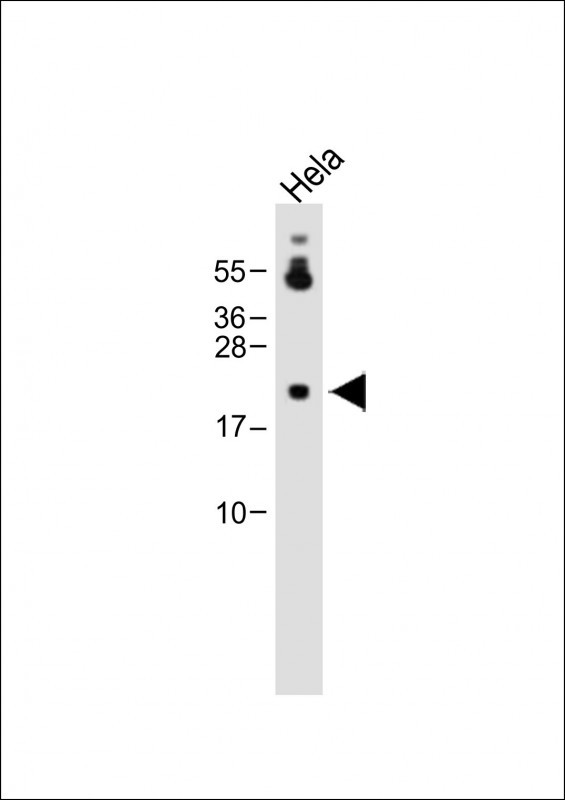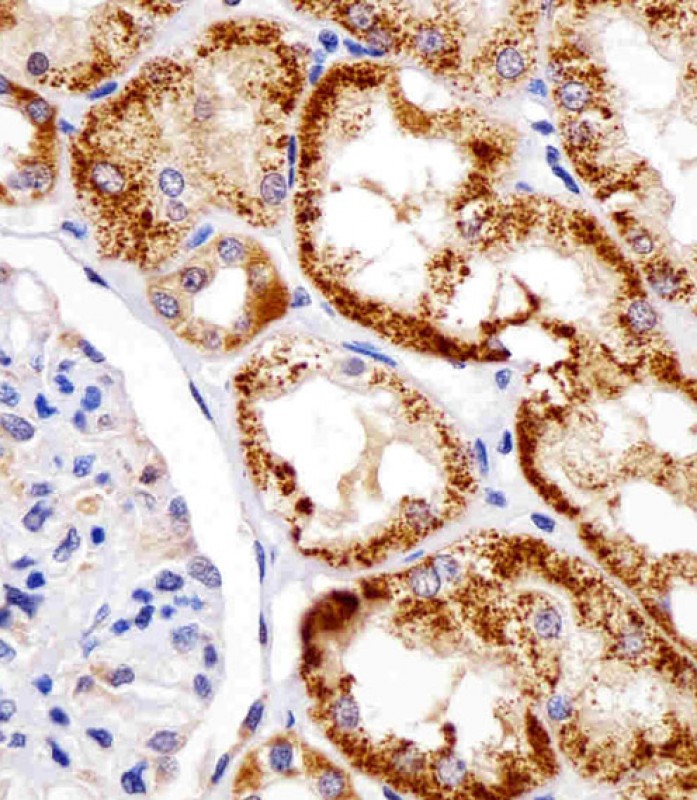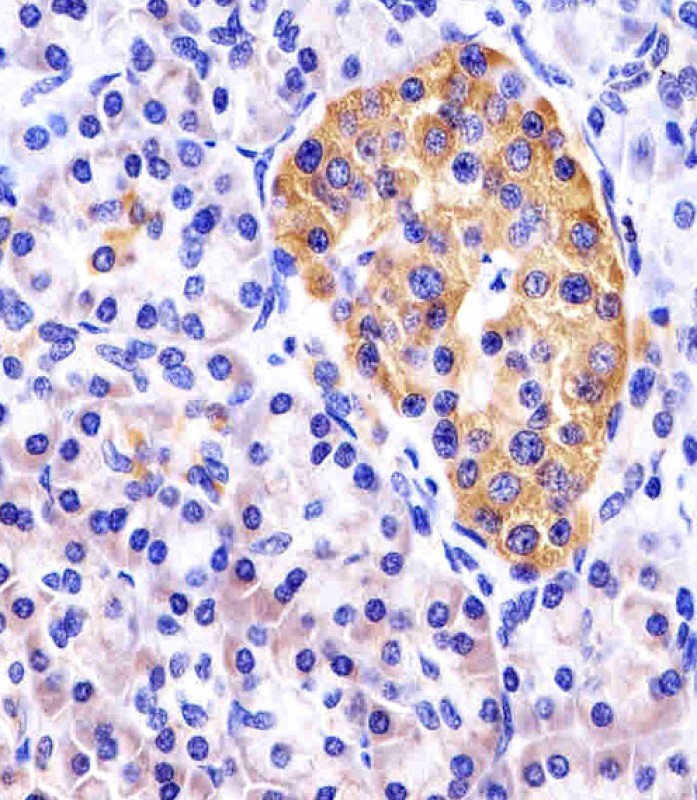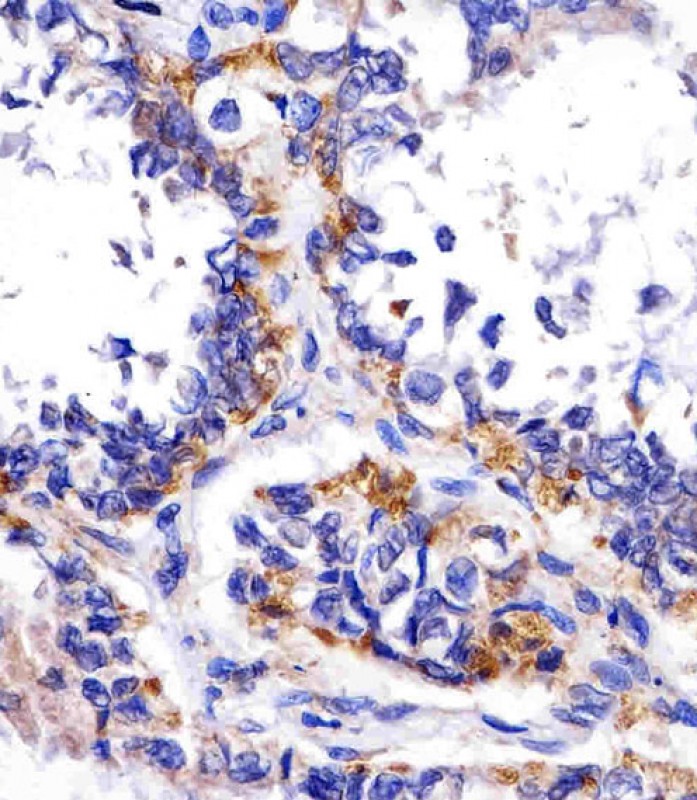DDIT4 Antibody (N-term)
Purified Rabbit Polyclonal Antibody (Pab)
- SPECIFICATION
- CITATIONS
- PROTOCOLS
- BACKGROUND

Application
| WB, IHC-P, E |
|---|---|
| Primary Accession | Q9NX09 |
| Reactivity | Human |
| Host | Rabbit |
| Clonality | Polyclonal |
| Isotype | Rabbit IgG |
| Calculated MW | 25371 Da |
| Antigen Region | 20-49 aa |
| Gene ID | 54541 |
|---|---|
| Other Names | DNA damage-inducible transcript 4 protein, HIF-1 responsive protein RTP801, Protein regulated in development and DNA damage response 1, REDD-1, DDIT4, REDD1, RTP801 |
| Target/Specificity | This DDIT4 antibody is generated from rabbits immunized with a KLH conjugated synthetic peptide between 20-49 amino acids from the N-terminal region of human DDIT4. |
| Dilution | WB~~1:2000 IHC-P~~1:25 |
| Format | Purified polyclonal antibody supplied in PBS with 0.09% (W/V) sodium azide. This antibody is purified through a protein A column, followed by peptide affinity purification. |
| Storage | Maintain refrigerated at 2-8°C for up to 2 weeks. For long term storage store at -20°C in small aliquots to prevent freeze-thaw cycles. |
| Precautions | DDIT4 Antibody (N-term) is for research use only and not for use in diagnostic or therapeutic procedures. |
| Name | DDIT4 |
|---|---|
| Synonyms | REDD1, RTP801 |
| Function | Regulates cell growth, proliferation and survival via inhibition of the activity of the mammalian target of rapamycin complex 1 (mTORC1). Inhibition of mTORC1 is mediated by a pathway that involves DDIT4/REDD1, AKT1, the TSC1-TSC2 complex and the GTPase RHEB. Plays an important role in responses to cellular energy levels and cellular stress, including responses to hypoxia and DNA damage. Regulates p53/TP53-mediated apoptosis in response to DNA damage via its effect on mTORC1 activity. Its role in the response to hypoxia depends on the cell type; it mediates mTORC1 inhibition in fibroblasts and thymocytes, but not in hepatocytes (By similarity). Required for mTORC1-mediated defense against viral protein synthesis and virus replication (By similarity). Inhibits neuronal differentiation and neurite outgrowth mediated by NGF via its effect on mTORC1 activity. Required for normal neuron migration during embryonic brain development. Plays a role in neuronal cell death. |
| Cellular Location | Mitochondrion. Cytoplasm, cytosol |
| Tissue Location | Broadly expressed, with lowest levels in brain, skeletal muscle and intestine. Up-regulated in substantia nigra neurons from Parkinson disease patients (at protein level) |

Thousands of laboratories across the world have published research that depended on the performance of antibodies from Abcepta to advance their research. Check out links to articles that cite our products in major peer-reviewed journals, organized by research category.
info@abcepta.com, and receive a free "I Love Antibodies" mug.
Provided below are standard protocols that you may find useful for product applications.
Background
REDD1 is a novel transcriptional target of p53 induced following DNA damage. During embryogenesis, REDD1 expression mirrors the tissue-specific pattern of the p53 family member p63, and TP63 null embryos show virtually no expression of REDD1, which is restored in mouse embryo fibroblasts following p63 expression. In differentiating primary keratinocytes, TP63 and REDD1 expression are coordinately downregulated, and ectopic expression of either gene inhibits in vitro differentiation. REDD1 appears to function in the regulation of reactive oxygen species (ROS); TP63 null fibroblasts have decreased ROS levels and reduced sensitivity to oxidative stress, which are both increased following ectopic expression of either TP63 or REDD1. Thus, REDD1 encodes a shared transcriptional target that implicates ROS in the p53-dependent DNA damage response and in p63-mediated regulation of epithelial differentiation.
References
Ellisen L.W., Mol. Cell 10:995-1005(2002).
Shoshani T.,Mol. Cell. Biol. 22:2283-2293(2002).
If you have used an Abcepta product and would like to share how it has performed, please click on the "Submit Review" button and provide the requested information. Our staff will examine and post your review and contact you if needed.
If you have any additional inquiries please email technical services at tech@abcepta.com.














 Foundational characteristics of cancer include proliferation, angiogenesis, migration, evasion of apoptosis, and cellular immortality. Find key markers for these cellular processes and antibodies to detect them.
Foundational characteristics of cancer include proliferation, angiogenesis, migration, evasion of apoptosis, and cellular immortality. Find key markers for these cellular processes and antibodies to detect them. The SUMOplot™ Analysis Program predicts and scores sumoylation sites in your protein. SUMOylation is a post-translational modification involved in various cellular processes, such as nuclear-cytosolic transport, transcriptional regulation, apoptosis, protein stability, response to stress, and progression through the cell cycle.
The SUMOplot™ Analysis Program predicts and scores sumoylation sites in your protein. SUMOylation is a post-translational modification involved in various cellular processes, such as nuclear-cytosolic transport, transcriptional regulation, apoptosis, protein stability, response to stress, and progression through the cell cycle. The Autophagy Receptor Motif Plotter predicts and scores autophagy receptor binding sites in your protein. Identifying proteins connected to this pathway is critical to understanding the role of autophagy in physiological as well as pathological processes such as development, differentiation, neurodegenerative diseases, stress, infection, and cancer.
The Autophagy Receptor Motif Plotter predicts and scores autophagy receptor binding sites in your protein. Identifying proteins connected to this pathway is critical to understanding the role of autophagy in physiological as well as pathological processes such as development, differentiation, neurodegenerative diseases, stress, infection, and cancer.





